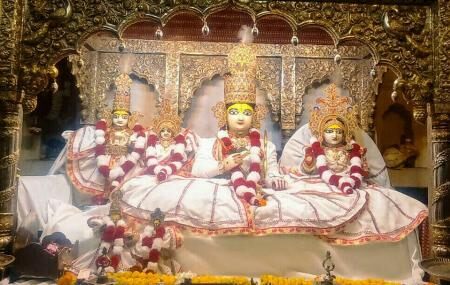In 1780, the ruler of Orchha Vikramajit (1776–1817) shifted his capital from Orchha to Tehri and renamed it Tikamgarh (Tikam is one of the names of Krishna).Vrishbhanu Kunwari, the Queen of Tikamgarh is said to have rebuilt or renovated Kanak Bhawan temple in Ayodhya . The temple is dedicated to Lord Rama and Goddess Sita and is located north-east of Ram Janma Bhoomi. It is said that this palatial building was gifted to the newly weds by King Dasharatha’s youngest queen, Kaikeyi. According to legend King Vikramaditya renovated it during the Gupta period around the 4-5th BCE.

The idols of Sri Rama and Sita Devi are seated instead of the usual standing stance, the reason being that they were relaxed in their homes. There is no idol of Lakshmana too for the same reason as the younger brother-in-law is not allowed in the sister-in-law’s abode.

Janaki Mandir in Janakpur in the Mithila region of Nepal, popularly known as the Nau Lakha Mandir was also built by Queen Vrishabhanu of in 1910 .Rani Mahal of Orchha is known well for the astounding architecture it has to boast about.The mahal also means the queen quarters. It was the royal chamber for the wife of Raja Madhukar Singh. He was greatly dedicated to Lord Rama and thus he decorated the rooms of the queen’s chamber with murals that depicted scenes from the great epics like Ramayana. The ceilings as well as walls both are festooned with beautiful paintings all over them.

In the reign of Jehangir, in 1618, Raja Veer Singh Deva Bundela of Orchha had built Keshavdeva temple at the cost of thirty-three lakhs in Mathura. A French traveller Tavernier visited Mathura in 1650 and had described the octagonal temple built in red sandstone. Italian traveller Niccolao Manucci who worked in Mughal court has also described the temple. Mughal prince Dara Shikoh had patronised the temple and donated a railing to the temple. The railing was removed Mathura governor Abdun Nabi Khan on the order of Mughal emperor Aurangzeb and he built Jama mosque on the ruins of the Hindu temples. During the Jat rebellion in Mathura, Abdul Nabi Khan was killed in 1669. Aurangzeb attacked Mathura and destroyed that Keshavdeva temple in 1670 and built Shahi Eidgah in its place.

No comments:
Post a Comment